|
One evening last November, College of Architecture and Urban Studies (CAUS) Assistant Professor of Architecture Joseph Wheeler was getting his poker chips ready for a game with some buddies. Across town, Robert Dunay, the T. A. Carter Professor of Architecture and chair of the industrial design program, was coming down with a nasty cold. Elsewhere, during holiday gatherings, families of CAUS and College of Engineering students were eager to hear firsthand about a recent national competition, the U.S. Department of Energy Solar Decathlon.
Wheeler, Dunay, other faculty, and students--who had all worked on Tech's decathlon entry for two years--had just returned from the competition's judging in Washington, D.C. Their multiple wins at the decathlon would be the college's biggest news for the 2005-06 academic year, and the team members were delighted to have the opportunity to catch their breath. Then the phone rang at Wheeler's house--it was CAUS Dean Paul Knox with news of an exciting, confidential service project that would engage many of the same faculty and students' expertise and innovations, and garner even broader national attention.
Bob Fetzer, president of Building Specialists Inc. of Roanoke, Va., a small building firm known for high-quality residential construction, had just contacted Knox with an unusual request between friends: to help him design a house in four days. Fetzer explained that his company had been tapped by the popular ABC television show "Extreme Makeover: Home Edition" to build a brand new house for Blacksburg resident Carol Crawford Smith and her two sons, Hunter and Garland.
Back in the saddle again
For the new house, Fetzer wanted a quality custom design that would be sure to accommodate Smith, who suffers from multiple sclerosis. Fetzer's designer, Amanda McCreary (architecture '04), would contribute to the plan, along with a group of outstanding students handpicked by Wheeler and Dunay: Chip Clark, a fifth-year architecture student from Fredericksburg, Va.; Ben McCreary, a fifth-year architecture student from Franklin, Tenn.; Brandon Lingenfeltser, a third-year architecture student from Blacksburg; and Tom Shockey, a fourth-year architecture student from Lake Forrest, Ill.
Fetzer also contacted Georgia-Anne Snyder-Falkinham Professor Yvan Beliveau, department head of building construction, to collaborate with Jonathan Hirst (building construction '92), vice president of operations at Building Specialists. Along with building construction professors Michael O'Brien and Thomas Mills, and Director of Virginia Tech's Center for Innovation in Construction Safety and Health Brian Kleiner, the group choreographed the timing of each facet of construction, from the movement of earth and trucks to the pitches of the design's gables, the mixtures of concrete, and more.
The design team was also challenged to create an additional space where Smith could meditate and practice the yoga that helps her manage the multiple sclerosis. Wheeler and Dunay agreed to procure all the necessary materials and build the detached meditation room with their students. The construction experience and industry contacts they had made only two months earlier at the Solar Decathlon were instrumental in the creation of the sophisticated prefabrication and assembly demanded by this project.
While members of the design and construction teams enjoyed turkey and cranberries with their families and friends, they were hard pressed to keep a lid on their big news, for these plans had only a possibility of coming to fruition and were being made under the strictest secrecy. The Smiths were one of four families in Virginia being considered for a home makeover, so there was no guarantee that the plans would ever be used. But if the Smiths were chosen, plans for their home's makeover had to be ready to go immediately after the announcement was made. Gossip about the plans would generate a false certainty that the honor would come to pass and therefore was strictly prohibited.
Wheeler had little trouble keeping the news quiet as he spent his Thanksgiving sequestered in his office, feverishly drawing the initial plans for Smith's house. Dunay, who had put off his holiday plans to work on the designs, instead came down with a case of flu that kept him homebound for a few days. Quietly, a web of faculty, students, and staff--with the College of Architecture and Urban Studies at its epicenter--began to weave itself across Virginia Tech's campus as plans took form and tasks were matched with volunteers.
While some labored in anxious silence, others heard about Smith's possible home makeover directly from her. Parents sitting in the run-down studio of Smith's ballet school, the Center of Dance, first learned about the possible makeover when she arrived for one mid-November class with a cameraman from ABC. He was in town collecting information about Smith while the family's bid for a home makeover was being considered. Thousands of people submit applications to "Extreme Makeover," and the show does its best to select outstanding people who give selflessly but who could use some serious help themselves and Smith fit that bill perfectly. [See below.]
Public relations representatives from the Town of Blacksburg, CAUS, and Building Specialists met privately to plan a possible media strategy, the visits of officials and major contributors to the build site, and resource management. Rachel Holloway, communication department head, managed a massive public relations student volunteer signup, asking students to work on what was only described as a possible major media event. These students ended up providing a great service by manning a tent on the build site where media received their credentials and press kits.
A good morning for the Smiths
On the morning of Dec. 4, Ty Pennington, lead designer for "Extreme Makeover: Home Edition," surprised Smith and her two sons at their home with his trademark bullhorn announcement: "Good morning, Smith family!" That was the first moment Smith knew that she would be on the show. The happy news spread across campus faster than a major football bowl announcement. While the faculty and student architecture and construction teams finally exhaled, several more Hokies asked how they could help and rolled up their sleeves to contribute to the project.
Truman Capone, department head of art and art history, helped coordinate the creation of a sunflower painting that some of Smith's young ballet students made with their feet. Steve Bickley, art professor and local sculptor, handcrafted iron handrails to be placed throughout Smith's house.
Ben Johnson, landscape architecture professor, who also lent his expertise to the project, was impressed by the camaraderie of all the workers on the site. "Typically these various tradespeople would find it very difficult, if not impossible, to work side by side--or on top of each other, as it turned out," he says. "But at this build, not once did I hear a cross word between volunteers. Never did I witness anything but courtesy and determination. It was a marvelous thing to witness."
Johnson and Wheeler worked with Holly Scoggins, associate professor of horticulture and Hahn Horticulture Garden director, who was contacted by an "Extreme Makeover" producer to help with plants for the meditation room's interior planter boxes. "For the meditation house, they said they wanted something 'Zen, simple, grassy,' but they had no idea as to what actual plants would lend this effect," says Scoggins. She pulled plants from the Department of Horticulture Teaching Collection with the help of Scott Rapier, greenhouse manager, and combed local nurseries for the types of plants that were right for the project, which proved difficult to find in the dead of winter in Blacksburg. Many of the nursery owners--including Fred Duis (horticulture '69) of Duis Nursery in Bedford, Va.; and Doug Jessee (horticulture '81), manager of Greenbrier Nursery, in Roanoke, Va.--were happy to help their alma mater and generously assisted Scoggins.
The Hokey Pokey brings down the house
On Tuesday, Dec. 6, David McKee, director of the Marching Virginians, rallied the band members who--despite having just returned from an out-of-town football game the day before--led hundreds of students wearing Hokie colors, along with the demolition team in trademark blue "Extreme Makeover" shirts and hard hats, from Main Street to the Smith house at 400 Ardmore Street. John Beach, director of physical plant operations, brought all eight colleges' commencement banners out of storage for the march. While Smith and her sons basked in the California sun on a vacation arranged by "Extreme Makeover," the Marching Virginians led a spirited round of "The Hokey Pokey" as the old house, with its multiple levels that were so unmanageable for Smith, came crashing down.
Meanwhile at Smith's studio, a last-minute scramble was underway. The original hope had been to find a new location for the Center of Dance because the current studio's 21 steps were becoming impossible for Smith to maneuver. The search had finally been exhausted and a new plan to overhaul the existing studio had been adopted only two days earlier. That day, Beliveau had been enjoying a snack with his grandchildren across the street from Smith's ballet studio when he was spotted and asked to lead the overhaul project. He accepted the challenge, immediately applied for an asbestos report, and enlisted the help of professors O'Brien and Mills, in addition to Britni Edwards, a graduate student in building construction from Chapel Hill, N.C.; Justin North, a fifth-year building construction student from Sea Girt, N.J.; Michael Depp, a fourth-year building construction student from Yorktown, Va.; Jonathan Talton, a first-year building construction student from Virginia Beach, Va.; Andrew McCoy, a doctoral building construction student from Nellysford, Va.; and Roy Sturgill, a doctoral civil and environmental engineering student from East Point, Ky.
On demolition day, Beliveau and his team received their asbestos report, then a building permit, and were tearing out floors and walls by that evening. They received a surprise on Wednesday morning when they learned that the HVAC system was fried. Newcomb Electric swooped in and replaced fire walls, ducts, and mechanical systems, making everything operational by Friday.
Central in helping Beliveau attain people with the specialized skills needed to finish the studio was Peter Kapsidelis (civil and electrical engineering '03; M.S. '04) with Turner Construction. "Pete worked eight to 10 hours at his job and then came over to help us. He hardly slept for four days," says Beliveau. Given less time to plan and execute the studio renovation than the teams at the Smith house, Beliveau, his colleagues and students, and a host of Smith's instructors and ballet moms worked around the clock to finish the job.
Meanwhile, at the Smith house and meditation room, a core group of students (in addition to Clark, McCreary, Shockey, and Lingenfeltser) was integral to the success of those projects: Nathan King, an industrial design graduate student from Christiansburg, Va.; Philip Hassell, a fourth-year electrical engineering student from Roanoke, Va.; Adam Tomey, fourth-year electrical engineering student from Cambridge, Md.; Brian Golden, fifth-year architecture student from Front Royal, Va.; Ben Mohr, graduate student in civil engineering from Colorado Springs, Co.; David Rariden, third-year architecture student from Ashburn, Va.; Jordan Lingenfeltser, third-year architecture student from Blacksburg; Elizabeth Kinkel, fourth-year architecture student from Northboro, Mass.; Colin Clary, third-year building construction student from Hampton, Va.; Casey Stone, third-year architecture student from Virginia Beach, Va.; and Brad Johnson, first-year industrial design student from Leesburg, Va.
Hundreds of other students, faculty, and staff made up a large percentage of the more than 4,000 people who volunteered for the project. "Extreme Makeover" producers said that the Smith family episode had more volunteers than any other build they've done. In addition, these volunteers endured ice, snow, and frigid temperatures that made the seemingly impossible schedule even more challenging.
|
|
|

|
|
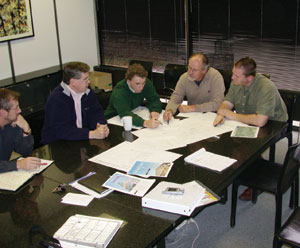
 Quietly, a web of faculty, students, and staff began to weave itself across campus as plans took form and tasks were matched with volunteers. Quietly, a web of faculty, students, and staff began to weave itself across campus as plans took form and tasks were matched with volunteers.
|
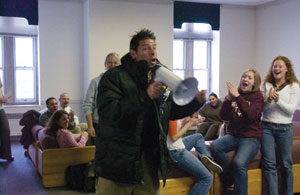
 "Extreme Makeover: Home Edition" star "Extreme Makeover: Home Edition" star
Ty Pennington jazzes up students.
|
|
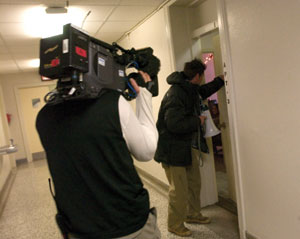
 Pennington poking around campus. Pennington poking around campus.
|
|
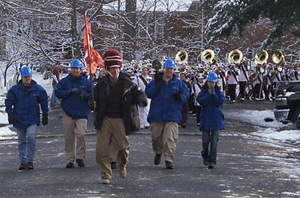
 The Marching Virginians led hundreds of students, along with the demolition team, to the Smith house. The Marching Virginians led hundreds of students, along with the demolition team, to the Smith house.
|
|
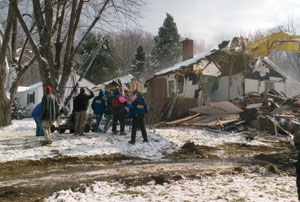
 Tearing down the old to make room for the new. Tearing down the old to make room for the new.
|
|
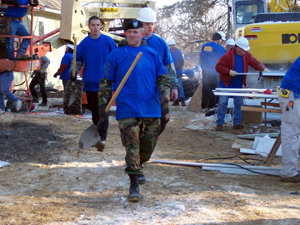
 Volunteers from Tech's Army ROTC Volunteers from Tech's Army ROTC
provided plenty of muscle.
|
|
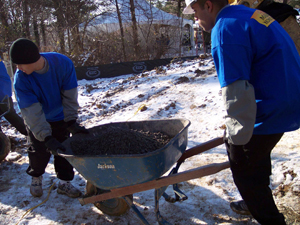
 Hundreds of students, faculty, and staff made Hundreds of students, faculty, and staff made
up a large percentage of the more than 4,000
people who volunteered for the project.
|
|

 Workers and volunteers toiled diligently Workers and volunteers toiled diligently
to complete the project in one short week.
|
|
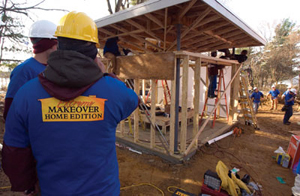 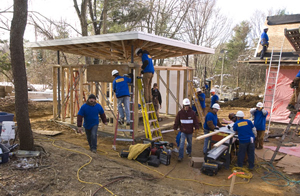
 Smith's new meditation room took shape Smith's new meditation room took shape
even as the house was being built.
|
|
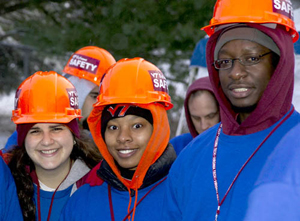
 Fifty faculty members and students served on Fifty faculty members and students served on
the "Extreme Safety Corps," led by Brian Kleiner,
director of Virginia Tech's Center for Innovation
in Construction Safety and Health.
|
|
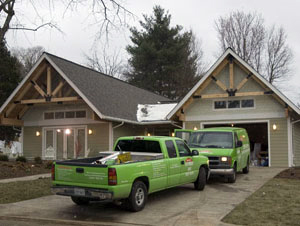
 The new house nearing completion. The new house nearing completion.
|
|

 "Extreme Makeover: Home Edition" producers "Extreme Makeover: Home Edition" producers
said that the Smith family episode had more
volunteers than any other build they've done.
|
|

